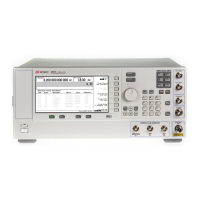E8257D/67D, E8663D PSG Signal Generators Service Guide
Troubleshooting
Reference/Synthesis Loop Description
1-95
FM Mode
FM rates up to 230 Hz are accomplished by combining the FM signal and the A6 Frac–N VCO tune signal to drive the
YIG Driver main coil.
FM rates above 230 Hz are accomplished using the FM drive circuit on the A9 YIG Driver to drive the FM coil in the
YIG Oscillator.
Sweep Mode
The A6 Frac–N maintains phase lock in sweep mode by providing the frequency correction voltage; in CW mode the
A5 Sampler provides the frequency correction voltage.
On the A6 Frac–N, the RF signal is downconverted to 5 MHz using fixed and programmable dividers. The RF 5 MHz
is compared to a 5 MHz reference developed by dividing 10 MHz from the A7 Reference by 2. The difference in phase
is integrated and a correction voltage is applied to the crossover circuit on the A9 YIG Driver. By using programmable
dividers, the RF side of the comparator can be kept at 5 MHz while the RF frequency sweeps. Because the instrument
can maintain phase lock while sweeping over a finite frequency range, the A6 Frac–N divide numbers are changed at
filter switch points and band crossings.
A7 Reference
Clean and stable reference signals are essential for low phase noise. In this case, two reference signals are provided:
• 1 GHz (to the A5 Sampler and the A8 Output, for down conversion)
• 10 MHz (to the A6 Frac–N for VCO phase coherency, and the A9 YIG Driver for DDS clock and baseband generator
accuracy).
The standard A7 Reference uses a 1 GHz STW Oscillator and 10 MHz OCXO.
The low phase noise A7 Reference (Option UNR/UNX) uses a 100 MHz VCXO that is multiplied by 10 to achieve
1 GHz, and a high performance 10 MHz OCXO.
The A7 Reference contributes to phase noise between 100 Hz and 10 KHz. See the “A6 Frac–N” assembly description
on page 1- 94, for more information on phase noise.
A9 YIG Driver
CW Mode
The A9 YIG Driver provides the A28 YIG Oscillator tune voltage. Coarse tuning of the A28 YIG Oscillator occurs when
the A18 CPU sets the pre–tune DAC’s output voltage to a value that sets the YIG oscillator frequency close to the
desired frequency. 3.2 volts out of the pre–tune DAC results in a 3.2 GHz YIG oscillator output. The A28 YIG
Oscillator output (in GHz) is proportional to the pre–tuned DAC output (in volts).
The A6 Frac–N and A5 Sampler compare the phase of a reference signal and the YIG oscillator frequency. A
correction voltage is generated and summed with the pre–tune voltage on the A9 YIG Driver, which fine tunes the
A28 YIG Oscillator to the desired frequency. For higher rate FM operation, the FM signal is scaled and the gain
calibrated on the A9 YIG Driver before being used to drive the FM coil in the A28 YIG Oscillator.
Both the A9 YIG Driver and the A28 YIG Oscillator contribute to phase noise between 100 KHz and 1 MHz.
Ramp Sweep Mode (Option 007)
In sweep mode the A9 YIG Driver provides the tune voltage for the YIG oscillator, generates the sweep voltage, and
provides the ALC Reference correction used during sweep.
The A9 YIG Driver has two similar circuits that generate:
• rear panel sweep out signal
•YIG sweep voltage
The hardware in these two circuits is identical, and includes:
• a sweep rate clock that is a digitally developed synthesis (DDS) chip with an output frequency of 0 to 25 MHz. A
10 MHz signal from the A7 Reference maintains the DDS frequency accuracy, and its output frequency clocks the
programmable counter at its output rate.
• a programmable counter that can count either up or down; its output increments the sweep DAC.
•a sweep DAC

